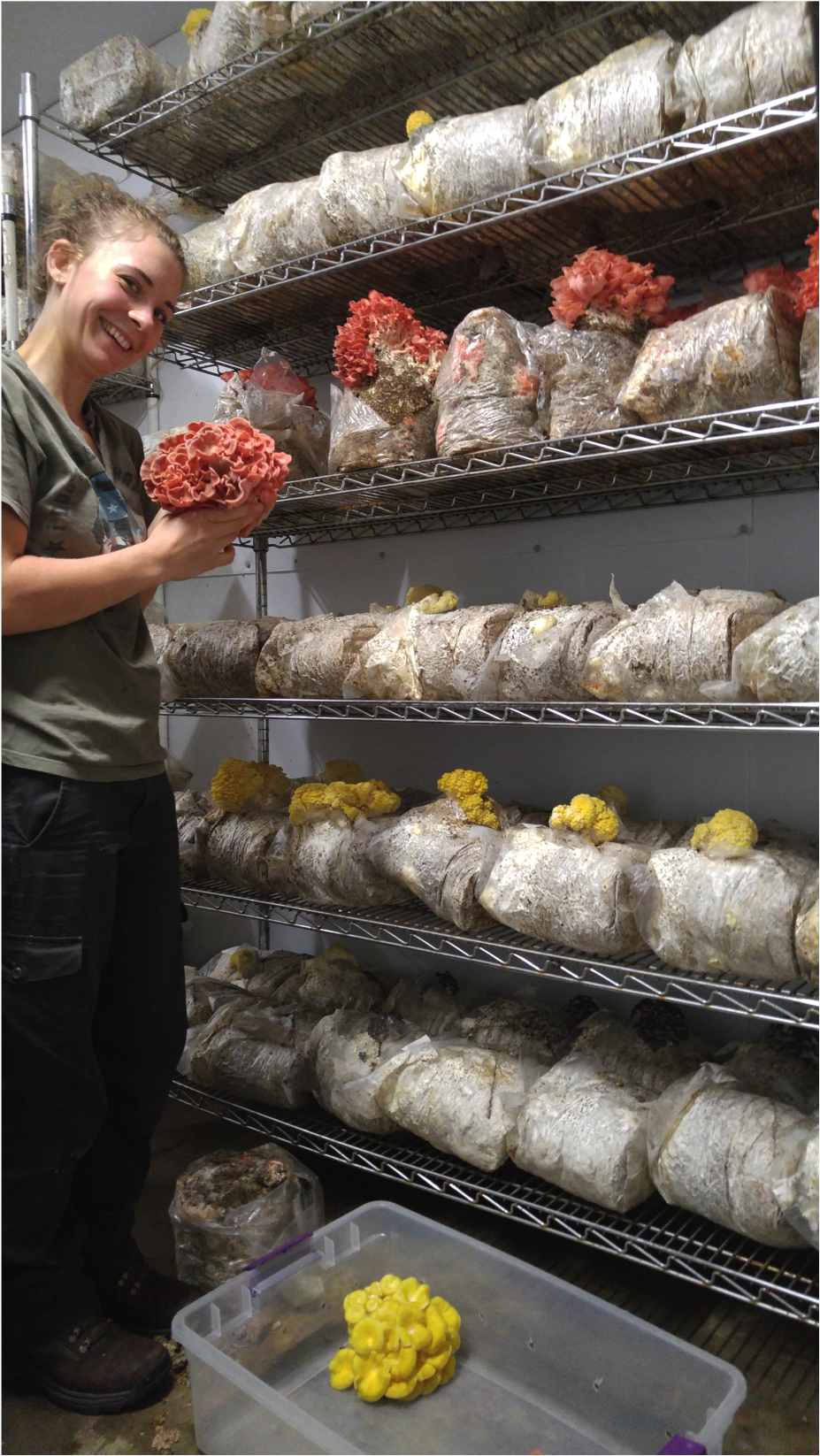Learn about mushroom farming, including the process for starting a mushroom farm or growing mushrooms commercially. Learn from experienced mushroom farmers
In this post we explore commercial mushroom farming; How to start slow and make a profitable business from becoming mushroom farmers and growing mushrooms. Starting a mushroom farm business can be a large undertaking. First this article walks through the basics of the processes involved in mushroom cultivation and then dives into the typical division found in the mushroom industry. If you want actionable tips on how to start a mushroom farm, then check out our online commercial mushroom growing course now.

There are many different ways to start a mushroom farm for growing mushrooms. The process that Fungi Ally went through while starting a mushroom farm business was going from outdoor log cultivation to indoor cultivation on straw, to purchasing ready-to-fruit blocks and then indoor cultivation on supplemented sawdust.
Our focus as mushroom farmers has been commercial mushroom farming for the last three years. We have also taught other mushroom farmers on how to farm mushrooms commercially. How to start a mushroom farm that is focused on log cultivation is relatively straight forward. Here is a great resource for mushroom famers on this method of cultivation. They have done extensive research into shiitake production cycle and cost/benefit analysis for starting log cultivation. In commercial mushroom farming, log cultivation can be difficult to actually make money. It is a very labor intensive and slow growing method for how to farm mushrooms.
One huge benefit of this type of mushroom farming is that most of the time is spent outdoors and minimal initial investment is needed. Finding logs through a tree company or forester, purchasing spawn, and doing the initial inoculation will get you started growing mushrooms. Starting a mushroom farm that focuses on indoor cultivation takes a little more planning, technical experience, and investment.
This is the method of commercial mushroom farming that most mushrooms found in the grocery store or at farmers’ markets are grown with. How to start a mushroom farm like this requires the development of infrastructure to:
- Treat substrate
- Inoculate
- Incubate
- Fruit
- Store mushrooms
- Compost
Mushroom farming begins for many mushroom farmers by paying for parts of the process to be done off farm.
We offer ready-to-fruit blocks for commercial mushroom farmers in the northeast that do not have the equipment for treating, inoculating, and incubating mushrooms to start. This makes starting a mushroom farm business a much easier task as you only need to worry about growing mushrooms, fruiting and selling them to start with. Shipping can be an expensive part of starting a mushroom farm this way so try to find a local supplier of blocks. Are you interested in bulk ready-to-fruit blocks? We can offer wholesale rates to mushroom farmers if you are interested in a minimum purchase of 20 blocks of the same mushroom species. Here is a breakdown of our whole rates:
- 20-50 kits: $20 per kit
- 51-100 kits: $18 per kit
- 101-150 kits: $16 per kit
- 150+ kits: $14 per kit
Bulk orders require notice and prep. Are you among the mushroom farmers who want to take advantage of bulk rates? Contact our sales team directly to discuss and place your order: 978-844-1811
How mushroom farmers treat substrate for mushroom farming
To learn more about growing oyster mushrooms on straw visit this article on the topic. This booklet outlines several different methods for treating straw for growing mushrooms. Another option is to autoclave the material at 15 psi for 2 hours or use atmospheric steam, keeping the material at 210 degrees F for 16 hours.
When you start a mushroom farm, it is important to think beforehand what method you want to treat substrate with because this will greatly impact the infrastructure and scale of production you will explore. For growing mushrooms we currently use atmospheric steam with a sauna steamer and a metal trough to treat 180 bags at a time.

Inoculation for mushroom farming
Inoculation on a commercial mushroom farm varies depending on the substrate. If mushroom farmers are using straw and pasteurizing or treating with lime, inoculation can happen in the open air. If mushroom farmers are starting a mushroom farm that uses supplemented sawdust you will need to inoculate in a lab. A lab is essentially a dedicated room with a flow hood in it that cleans all the air. All inoculations should take place in front of the flow hood if using supplemented sawdust while mushroom farming.

Incubation for mushroom farming: Incubation is the next step. There are a range of ways to incubate, but in essence, it is the process of allowing the mushroom mycelium to colonize the substrate. The bags need to have space between each other so heat does not build up and some air movement allows for faster incubation.
Fruiting while mushroom farming: For indoor commercial mushroom farming, the whole cycle with oysters typically takes about 6-8 weeks. Fruiting the mushrooms takes a specialized room where temperature, humidity, CO2, and lighting is controlled. Temperature can range between 55 and 75 degrees; different strains and species of mushroom can be grown as the temperature vary or wide temperature fruiting strains can be used. When developing a mushroom farm, the fruiting room is an important place to dial in. Keeping CO2 ppm below 800 is necessary for mushroom farming. In practical terms this means exchanging all the air in a room every 10-15 minutes. Humidity should be kept between 80-95% during pinning and 70-85% during fruit body development. It can be advantageous to drop the humidity several hours before harvesting to increase storage and quality of mushrooms.
Storage and compost for mushroom farming: Storing the mushrooms should be done in a container which allows airflow. The mushrooms should be allowed to breath and not stacked too high on top of each other. On a commercial mushroom farm immediately after harvest the mushrooms are placed into cold storage at 34-37 degrees. The substrate can be used to fruit an additional time or composted.
Starting a mushroom farm: Dividing the industry into 3 steps
In the mushroom farming industry there are really three distinct parts to the process. There are many examples of farms starting and growing rapidly because they simply focus on one part of this process rather than doing all three in house. If one aspect of this is mastered it becomes easier to bring another step under the umbrella of your business and either increasing revenue or reducing COGS easily. The three divisions of a mushroom farming business are:- Fruiting
- Substrate preparation and inoculation
- Spawn production
I recommend people starting a mushroom farm to focus on fruiting and start by purchasing ready-to-fruit blocks from another supplier. This allows the grower to invest only in the infrastructure needed for fruiting and selling the mushrooms. It allows the grower to become very familiar with the fruiting conditions of the mushrooms and the market in their local area. This allows the farmer to rapidly establish a market and customer base they know will support the business they want before investing to much into rental properties or equipment.
Once the market is established and fruiting conditions and schedule are dialed in the farmer can choose to bring the next piece in house for growing mushrooms if they so choose.
As more tasks are brought onto the farm usually employees are needed to keep the farm running smoothly and allow the farmer to have the life they want. This is another reason I recommend starting a mushroom farm one step at a time. It allows someone to efficiently develop systems and train new employees to completely take care of that aspect of the business. This would allow the farmer to then focus on building out a laboratory and work in the lab knowing the fruiting and sales aspect of the business is still running smoothly.
More and more mushroom farms are focusing on fruiting block sales. Likely within the next 10 years there will be farms throughout the country that sell ready-to-fruit blocks for prices that allow it to be viable for growing mushrooms commercially. Shipping is typically the most expensive aspect of doing business like this.
These blocks need to be stored in a walk-in cooler and then can be brought into fruiting conditions over a 3-4 week schedule.
Say you wanted to grow 100 pounds per week. If you were allowing for two flushes in the grow room you would want to buy 300 blocks for a month. Initiate 75 blocks for growing mushrooms per week and you would have roughly 100 pounds of mushrooms weekly.
When starting a mushroom farm spawn production is an essential and important aspect of growing mushrooms. If you are just starting at the commercial level there are people that are making better spawn than you are. I would recommend finding a provider that you work well with, has high quality strains, and good customer service and purchase spawn from them. This eliminates the stress and doubt that comes from using your own spawn at first. After several years this is something you can bring in house to have more control in how to farm mushrooms.
To produce spawn right typically more infrastructure, employees, and skills are needed. Allow these to build slowly rather than trying to do everything at once, especially as you learn how to farm mushrooms. Starting a mushroom farm can be a large undertaking. If you are doing it yourself, be sure to ask lots of questions on growing mushrooms and tour some mushroom farms before diving in. We have found commercial mushroom farming to be very rewarding in providing a great product to our community and making a livelihood. Learn more about our online class to boost start your farm.

